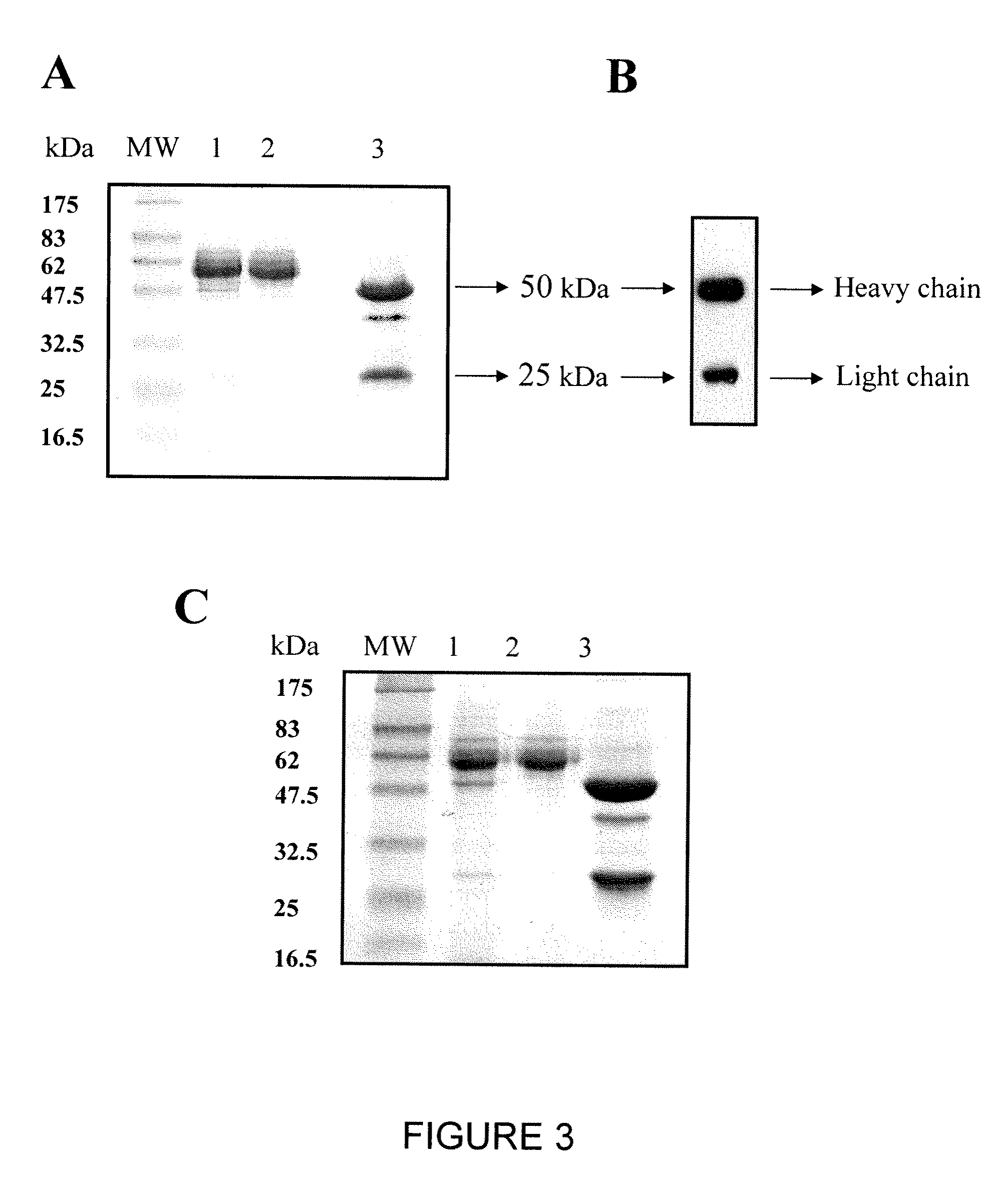Recombinant fusion protein and polynucleotide construct for immunotoxin production
a fusion protein and polynucleotide technology, applied in the field of polynucleotide constructs encoding fusion proteins, can solve the problems of excessive toxicity, cell death, poor anti-tumor effect in animals or humans,
- Summary
- Abstract
- Description
- Claims
- Application Information
AI Technical Summary
Benefits of technology
Problems solved by technology
Method used
Image
Examples
example 1
Construction of Mammalian Expression Vectors for Human IgG1 Derivatives
[0180]Mammalian vector pMAZ-IgH for human γ1 heavy chain expression and pMAZ-IgL for human κ light chain expression were designed for production of human IgG1 antibodies in mammalian cell culture (FIG. 1). Each vector carries the germline sequence of the respective heavy or light chain gene including its polyadenylation site located downstream of the translation termination codon. VH domains are introduced into the IgH expression vector via the BssHII and NheI restriction sites, whereas, VL domains are cloned into the IgL expression vector as BssHII and BsiWI fragments. The IgH plasmid carries a neomycine expression cassette for geneticin (G418) selection, while the IgL plasmid carries a hygromycin B resistance cassette for the isolation of stable transfectants. The strong human cytomegalovirus early promoter drives both the heavy and light chain genes. In addition, both vectors contain an ampicillin selectable m...
example 2
Expression and Purification of Chimeric IgG1 Derivatives
[0183]Chimeric H23 and FRP5 IgG antibodies were purified from stable 293 cell lines B2 and G1, respectively, grown in FCS stepwise starvation media as described in Materials and Methods. Stepwise starvation of the cells to FCS not only minimized the contamination with bovine IgG upon purification on protein A column, but also increased the amount of antibody secreted to the medium by the FCS deprived cells. Under these conditions, more than 95% pure chimeric IgG1 protein was obtained based upon separation on 12% / SDS-PAGE under reducing conditions and verification of human Ig heavy and light chain production by Western-Blot (FIG. 3). Anti-MUC1 chH23 and anti ErbB2 chFRP5 IgG1 antibodies were purified at a total yield of 20 mg per liter of culture.
example 3
Analysis of chH23 IgG1 Apparent Binding Affinity to MUC1
[0184]To compare the binding affinities of chH23 IgG1 with that of H23 mAb, we performed a comparative half-maximal binding assay using ELISA. The results indicated that purified chH23 IgG1 binds MUC1 similarly to the parental mAb. Determination of the apparent binding affinities KD of the two antibodies from the half-maximal binding signal revealed that both antibodies bind MUC1 with similar apparent affinities, 0.2 nM for the murine mAb and 0.3 nM for chH23 (FIG. 4). These results suggest that indeed conversion of the antibody from a monovalent format (Mazor et al., 2005 supra) to a bivalent format as the chimeric H23 is, increased the antibody's apparent binding affinity more then a hundred-fold, to a level roughly equal to that of the parental H23 mAb. This is not surprising, considering the repetitive nature of the MUC1 antigen that allows for avidity of the bivalent IgG that are directed to the VNTR region to be manifeste...
PUM
| Property | Measurement | Unit |
|---|---|---|
| volume | aaaaa | aaaaa |
| concentrations | aaaaa | aaaaa |
| concentration | aaaaa | aaaaa |
Abstract
Description
Claims
Application Information
 Login to View More
Login to View More - R&D
- Intellectual Property
- Life Sciences
- Materials
- Tech Scout
- Unparalleled Data Quality
- Higher Quality Content
- 60% Fewer Hallucinations
Browse by: Latest US Patents, China's latest patents, Technical Efficacy Thesaurus, Application Domain, Technology Topic, Popular Technical Reports.
© 2025 PatSnap. All rights reserved.Legal|Privacy policy|Modern Slavery Act Transparency Statement|Sitemap|About US| Contact US: help@patsnap.com



